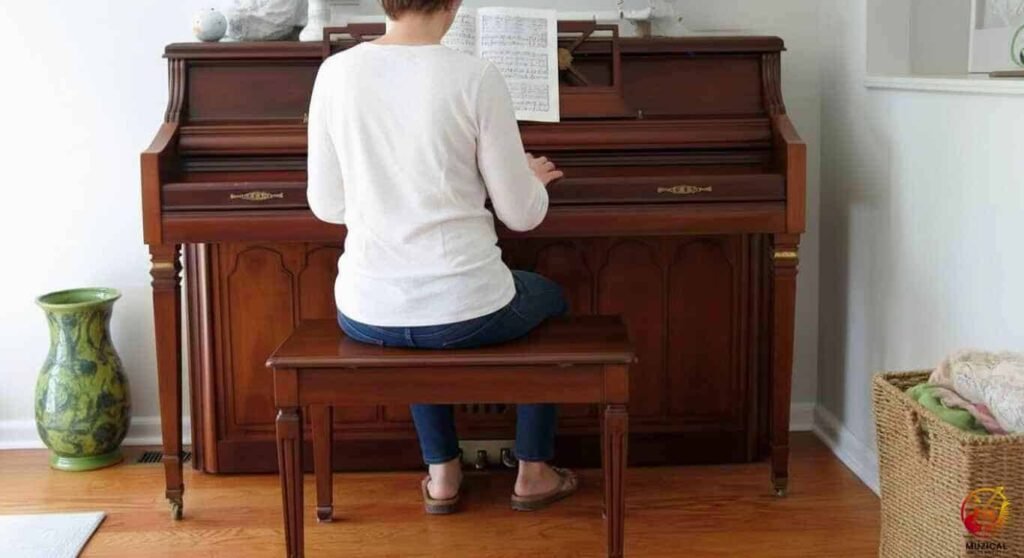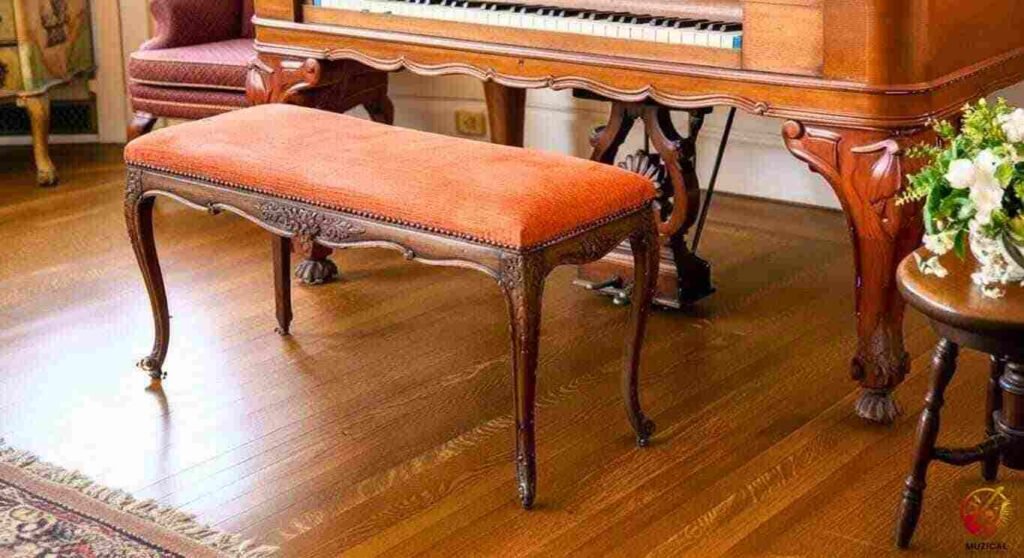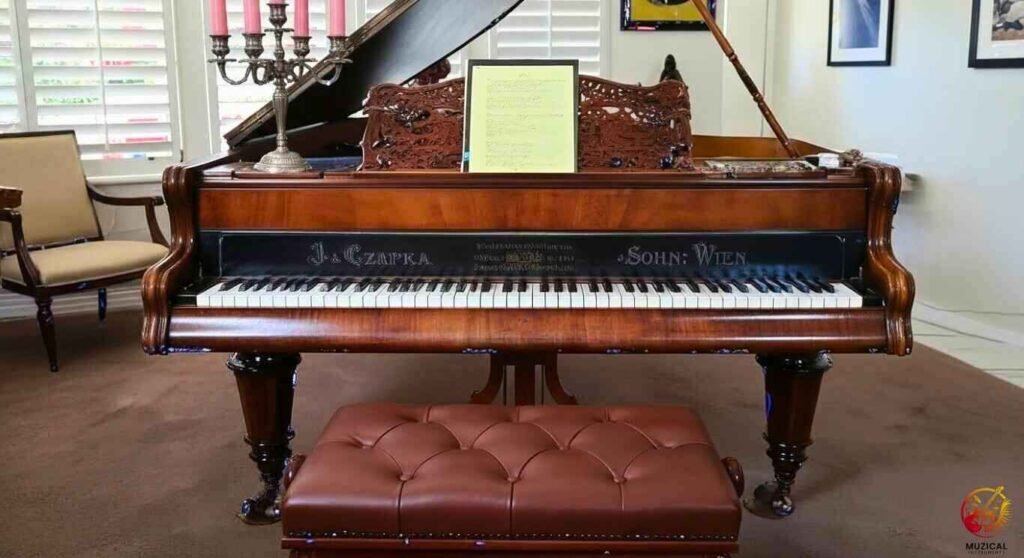The Top 7 Benefits of Using a Piano Bench Cushion
So many accessories exist for pianists: metronomes, page turners, fancy lights, and, yes, piano bench cushions.
Which ones actually help you play better?
It’s easy to look at a cushion and think it’s just a “nice to have.” A fluffy extra. A waste of money. But for your posture, comfort, and playing longevity, it can make a big difference.
A piano bench cushion is one of the best investments you can make, right after lessons and a tuned piano.
If you want to know why, keep reading. I’m breaking down the 7 key benefits of using a piano bench cushion and who needs one (and who doesn’t).
Why Is a Hard Piano Bench So Bad, Anyway?

Before we get to the “wins,” let’s talk about the enemy: the standard wooden piano bench.
They look classic, right? They match the beautiful Steinway or Yamaha piano. But from an ergonomic standpoint, they are terrible.
- They create “hotspots.” All your weight presses down on two small points (your “sit bones” or ischial tuberosities).
- They cut off circulation. This pressure pinches nerves and blood vessels, leading to that “pins and needles” feeling or numbness in your legs.
- They encourage slouching. To relieve the pressure, you instinctively roll your pelvis backward. Your lower back rounds, your shoulders hunch, and your whole spine alignment goes out the window.
- They are unforgiving. There is zero shock absorption. Every time you sit, shift, or move to reach high or low notes, it’s a hard impact.
The result? Your practice sessions are cut short by pain, not by lack of time or motivation. You get up feeling stiff, sore, and frustrated.
The 7 Core Benefits of Using a Piano Bench Cushion
This is where the cushion steps in. It’s not about being “comfy” like a sofa. It’s about support and endurance.

Here’s the breakdown of what a good cushion actually does.
1. Corrects Your Posture and Spine Alignment
This is the most important benefit. Piano posture and comfort are not separate ideas; they are directly linked.
A proper cushion (made of high-density foam or memory foam) distributes your weight evenly. It supports your sit bones without letting them sink in.
This stable base makes it easier to sit up straight. It helps you tilt your pelvis slightly forward, which is the foundation for a straight, healthy spine.
- No Cushion: You slouch to avoid pain. Bad posture = bad technique, tired arms, and back pain.
- With Cushion: You sit tall naturally. Good posture = better arm/wrist angle, more control, and no lumbar strain.
2. Longer, Pain-Free Practice Sessions
How long is your average practice session? 30 minutes? An hour?
How often do you stop because your back aches or your butt is numb?
A cushion directly fights this fatigue. By removing those pressure points and supporting your spine, it eliminates the #1 reason people stop practicing. You’ll be able to focus on your sheet music and dynamics, not the growing ache in your lower back. This is one of the biggest piano seat cushion advantages.
3. Improves Blood Circulation
Ever stand up from the piano and have to wait a second for your legs to “wake up”?
That numbness is from compressed nerves and poor blood flow. A hard bench acts like a clamp.
A cushion’s “give” allows your blood to flow freely. This means more oxygen to your muscles, less stiffness, and no more “dead leg” when you stand up after mastering a difficult passage.
4. Reduces Coccyx and Sciatica Pain
For many people, this is the only reason they need.
The coccyx (tailbone) is extremely sensitive. Sitting on a hard surface can feel like sitting on a rock, leading to bruising and inflammation.
Likewise, if you have sciatica, pressure on the back of your thighs and glutes can send pain shooting down your leg. A supportive cushion “floats” these sensitive areas, taking the pressure off the tailbone and the sciatic nerve.
5. Adds Stability (If You Get the Right One)
This might sound strange. You’d think “soft” means “wobbly.”
But a good piano cushion isn’t soft. It’s firm and supportive. Many come with a non-slip grip on the bottom.
This increases your stability. You aren’t sliding around on slick wood or vinyl. You are anchored in one place, which lets you put all your energy and motion into the keys, not into staying balanced.
6. Protects Your Piano Bench
This is a simple, practical bonus.
- Wood Benches: A cushion protects the wood finish from scratches from belts, buttons on pants, or just general wear and tear.
- Vinyl/Leather Benches: It prevents the upholstery from cracking, fading, or tearing over time.
Think of it as a cheap insurance policy for your expensive bench.
7. Better Temperature Control
Let’s be honest.
In the winter, a wooden bench is freezing cold.
In the summer, a vinyl bench is sticky and sweaty.
A cushion with a breathable fabric cover (like velour or cotton) stays at a neutral, comfortable temperature all year round. It’s a small thing, but it removes one more tiny distraction.
How Do I Know If I Need a Piano Bench Cushion?

Still not sure? Here’s a quick checklist. If you say “yes” to two or more of these, you should seriously consider a cushion.
- Do you stop practicing because of pain or stiffness?
- Does your lower back ache after 20-30 minutes?
- Do your legs or glutes ever feel numb or tingly?
- Do you find yourself fidgeting or shifting your weight constantly?
- Do you have diagnosed sciatica or tailbone pain?
- Is your bench top made of hard wood or cracking vinyl?
- Do you want to practice longer, but just can’t stand sitting there?
Can’t I Just Use a Regular Pillow or Chair Cushion?
This is the most common beginner mistake.
The answer is a hard NO.
If you use a bed pillow or a dining chair cushion. Here’s what happened.
| Problem | Why It’s a Disaster for Piano |
|---|---|
| Too Soft | A pillow offers zero support. You sink into it, which forces your pelvis to roll back and your spine to curve. It’s worse than a hard bench. |
| Too Unstable | You’ll wobble. Your body will be so busy trying to stay balanced that your technique, timing, and control will suffer. |
| Slides Around | Pillows and chair cushions don’t have non-slip grips. You’ll slide off-center, constantly having to re-adjust your position. |
| Wrong Shape | They aren’t designed for a bench. They bunch up, hang off the edges, and create new pressure points. |
A real piano bench cushion is an ergonomic tool. A pillow is a comfort item. They are not the same.
What to Look For: My Top Piano Bench Comfort Tips

You’re convinced. You’re ready to buy one. What makes a good one?
There are tons of options: foam, gel, pads, covers…
Let’s cut through the noise. Here’s what matters.
1. The Material: Foam Is King
This is the most important choice.
| Material | Best For… | Why? |
|---|---|---|
| High-Density Foam | Almost Everyone. This is the winner. | Firm, supportive, and durable. It won’t flatten out in six months. It provides support, not just “mush.” |
| Memory Foam | Pain Relief. | Excellent at contouring to your body and relieving pressure. Great for coccyx pain. Can be warm. |
| Gel / Foam Hybrid | Cooling. | Good for pressure relief and helps keep you cool. Often more expensive. |
| Just a Padded Cover | Nobody. | This is just a thin piece of fabric. It offers zero support and is a waste of money. |
2. The Critical Detail: Height and Your Bench
This is the part everyone forgets.
A cushion adds height.
- If your cushion is 2 inches thick, you are now sitting 2 inches higher.
- This will change your arm angle, shoulder position, and wrist technique.
Rule 1: If you have an adjustable piano bench, you are in the clear. Just buy the cushion and lower your bench by the same amount to keep your perfect playing height.
Rule 2: If you have a fixed-height bench (one that doesn’t adjust), you must be careful.
- If you are a shorter person and were already sitting too low, a cushion might fix your height and comfort. This is a double win!
- If you are tall and were already at the perfect height, a thick cushion will make you sit too high. This can cause new shoulder and wrist pain. In this case, you should look for a very thin (1-inch) cushion or buy an adjustable bench.
3. Quick-Buy Checklist
Use this table when you’re shopping.
| Feature | My Recommendation (What to Look For) |
|---|---|
| Material | High-Density Foam or Memory Foam (at least 1.5″ thick) |
| Size | Measure your bench! Get one that covers most of the top. |
| Bottom | A non-slip rubber bottom. This is not optional. |
| Cover | A removable, washable cover. (Velour or breathable fabric is best). |
| Straps | Straps are “okay” but a good non-slip bottom is better. |
The Final Verdict
So, what’s the final answer on why use a piano bench cushion?
A high-quality cushion isn’t a luxury accessory. It’s a fundamental tool for health and endurance.
The benefits of using a piano bench cushion are massive. It fixes your posture, eliminates pain, and removes the biggest physical barrier to longer, more focused, and more productive practice sessions.
Stop letting that hard wooden bench cut your practice time short. Your back, your focus, and your music will thank you.
FAQ: Top 7 Benefits of Using a Piano Bench Cushion
1. Is a piano bench cushion really necessary?
It’s not a must-have to make sound, but it is very important for your comfort and posture. A good cushion helps you sit straight, which stops back and leg pain. This means you can practice longer and feel much better.
2. Does a piano cushion help with posture?
Yes, that is one of its biggest benefits. A hard bench makes you slouch to avoid pain. A good, firm cushion supports your sit bones. This makes it much easier to sit up straight, keep your spine aligned, and stop your lower back from getting sore.
3. How thick should a piano bench cushion be?
Look for a cushion that is about 1.5 to 3 inches thick. A 2-inch cushion is often perfect. You want it thick enough to stop pain, but not too thick. If it’s too high, it can make your shoulders and wrists feel sore by changing your arm angle.
4. What is the best material for a piano bench cushion?
The best material is high-density foam. This foam is firm and supportive, so you don’t sink. It won’t get flat after a few months. Memory foam is also a good choice, especially if you have tailbone pain and need it to shape to your body.
5. How do I choose the right size piano bench cushion?
First, get a tape measure and measure the top of your piano bench. Look for a cushion that is the same size or just a little bit smaller. You don’t want it hanging over the edges or sliding around because it’s too small. Many also come with a non-slip bottom to keep it in place.
